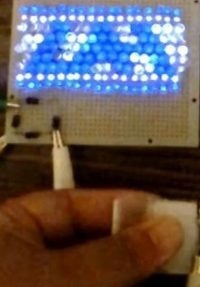With bitingly cold temperatures, winter generally brings dry air and the infrequent zap of static electricity.
 This adhesive tape-based nanogenerator can light several hundred LEDs. Image Credit: Adapted from ACS Omega, 2022
This adhesive tape-based nanogenerator can light several hundred LEDs. Image Credit: Adapted from ACS Omega, 2022
Those shocks may be irritating, but scientists are working to exploit wasted energy and triboelectric nanogenerators (TENGs) for use in powering daily devices.
In ACS Omega, researchers explain a simple method to manufacture such small generators out of materials as easy as double-sided store-bought tape that tends to be packed in higher energy densities than earlier reported versions.
Hence, TENGs have the potential to alter mechanical energy into electrical energy via the triboelectric effect, which also creates static electricity. However, rather than that static turning into a shock, such nanogenerators send it via a circuit to power a device, like an LED.
Based on easy principles, several TENG devices have been complex and costly to make and only generate a few watts of power. An earlier study has shown that streamlined TENGs can be created with a combination of plastic, tape, and metal. However, their low power densities have hindered them from being utilized in practical applications.
Hence, Gang Wang and collaborators wished to design a straightforward, simple-to-construct TENG that would work as well as highly advanced designs.
The scientists created a TENG with layers of store-bought double-sided tape and plastic film covered with a thin sheet of aluminum metal. When these two layers were joined and detached from one another, a small spark developed between them. Their ability to produce power increased with more pressure on the layers.
The TENG could produce persistent power densities with other highly complex versions. The scientists say that a double-electrode version of the device could also generate a power density of 169.6 W/m2—47% higher than those earlier reported for other devices.
In various tests, the group vigorously tested the TENG. When wired to a range of LEDs, the generator could illuminate more than 400 lights concurrently when someone pressed the layers.
Fixing the TENG to the bottom of a shoe could switch on LEDs with the power of a simple step. Moreover, the generator could force a laser diode, which could set the stage for use in sensors and light-based electronics.
The scientists state that this generator design could help fulfill the bigger power demands for self-powering electronics with easier and more affordable materials.
The authors acknowledge financial support from the College of Engineering at the University of Alabama in Huntsville and Materials Sciences LLC.
Journal Reference:
Jang, M-H., et al. (2022) Power Generation by a Double-Sided Tape. ACS Omega. doi: doi.org/10.1021/acsomega.2c05457.